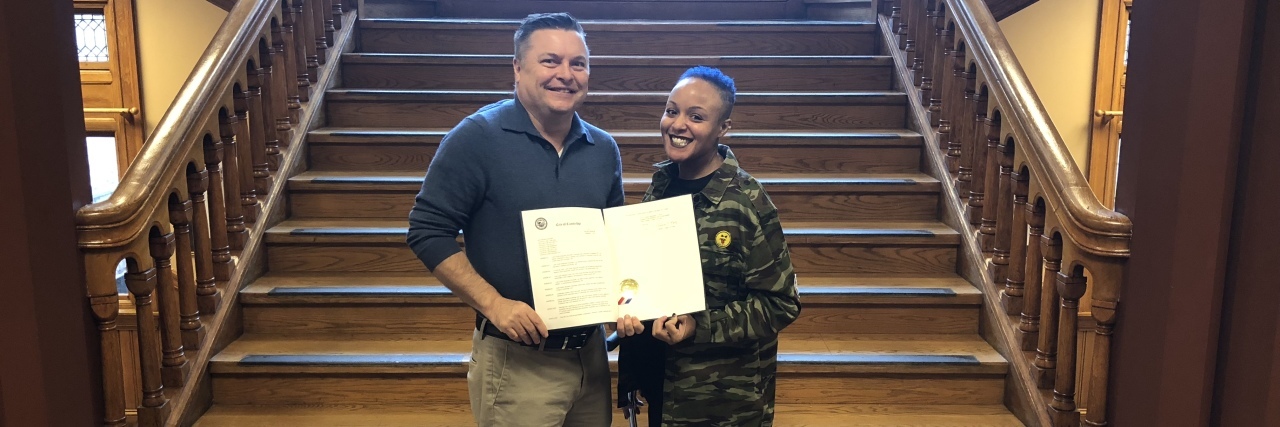Last year, I had the awesome opportunity to bring Limb Girdle Muscular Dystrophy Awareness Day to my hometown of Cambridge, Massachusetts as an official state ambassador. After taking the step to find and connect with other young adults living with MD, I found a Facebook page, as well as groups and an informative website that all help individuals with MD talk, connect and share stories and resources specific to what each person is experiencing. More than 20 people are currently in my support group. My friends here in Boston have a different type of MD, but can still relate to a lot of the daily challenges. Being able to just talk about what we are going through was and will continue to be priceless.
I decided last year to take a leap of faith and reached out to my mayor and governor to declare the first LGMD Awareness Day, which was held last September 30. I was able to go into the Chamber Office in City Hall of Cambridge to give my testimony about how LGMD has affected me before receiving a signed proclamation from Mayor Marc McGovern. Now the time has come again, and I want to help you spread the word and gain understanding about LGMD in hopes that others will start to spread awareness about chronic illnesses of all types.  What is Limb Girdle Muscular Dystrophy?
What is Limb Girdle Muscular Dystrophy?
According to LGMD-Info, it is:
- A term used for a group of rare neuromuscular diseases which are inherited and known to cause muscle weakness and wasting.
- The muscles most affected are those closest to the body (proximal muscles), specifically the muscles of the shoulders, upper arms, pelvic area and thighs.
- More than 30 forms of LGMD exist, with new forms (sub-types) being discovered each year.
- Some LGMD sub-types have a “dominant” inheritance and some have a “recessive” inheritance pattern.
- In some cases a family history exists and in others, no family history of the disease is known.
- Onset of symptoms can occur in childhood, adolescence or even adulthood.
- LGMD occurs in all parts of the world and among all ethnic groups.
- Males and females can inherit LGMD.
- No cure or treatment exists for these progressive diseases, although promising research is being carried out which gives hope to many individuals.

How LGMD Affects Me
LGMD affects my limbs from the arms down. Putting on a jacket and raising my arms up fully can be difficult for me. Even giving a hug can be a challenge, especially if someone rushes to embrace me and potentially knocks me over. Rolling out of the bed is not easy. It takes me a lot longer to do simple tasks the average adult can do with ease. Low seating, windy days, uneven pavement or gravel surfaces and even holding a cup can all be challenges to someone with LGMD.
The Symptoms I Live With
Lately, I have been experiencing back pain, which means it’s time to go back to physical therapy to learn some restorative stretches and workouts to keep my pain at minimum throughout the day. At this point, walking with my cane is getting uncomfortable, so getting a walker is an idea I will test out in the coming weeks. I see three neurologists and like getting each different perspective. Once I get my walker, I plan to pimp it out of course in Girls Chronically Rock style. I took four different tests and still haven’t pinpointed the exact sub-type I have. I get echocardiograms once a year to stay on top of everything going on in my body.
How It’s Treated
The only treatment I currently do is physical therapy, mostly in the pool, though it is getting difficult to get out of the water and change clothes. Through my process of dealing with LGMD, I have learned the pool is the best treatment for moving my muscles, in addition to physical therapy. I’m working on getting a PCA to help me continue all the everyday things that have become a challenge or unrealistic for me to do on my own.
Why Research and Community Are Key to Our Success
Without the help, support and empathy of my group members, I wouldn’t know how to travel well with MD, how to make it through rough days or how to face the many obstacles that come with this condition. Having the information is just one side of the coin. Having a community is key to having the right information and a wealth of opinions and first-hand experiences to help you live your best life, informatively and intentionally.
LGMD Awareness Day isn’t just about me. It’s about my friends, support groups and most importantly the newly diagnosed versions of me who may feel all alone after a life-changing conversation with their doctor. You are not alone. We are in this together.
If you’d like to help people with LGMD, you can donate to LGMD Awareness Day, or support MD research, initiatives, and communities through the Muscular Dystrophy Association. Spread the word. Spread the information. Spread the community.

